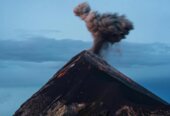Many of us might think of eruptions in Hawai’i when we think of lava flows, or recent eruptions in Iceland or La Palma in the Canary Islands. There are generally two main types that we group lava flows into. Pahoehoe is a runnier (less viscous) smoother lava, and ‘A’ā (“ah-ah”) are the more viscous flows with sharp, rubbly surfaces that move forward much like the tread on a bulldozer. In both cases you can usually out-walk lava flows, except for when they are moving within a channel or tube that keeps them hot and fluid. In terms of all the dangerous aspects of volcanoes, lava flows tend to be the less dangerous hazard type. This is not always the case.
Nyiragongo volcano in the Democratic Republic of the Congo unleashed deadly lava flows from its lava lake full of very hot and fluid molten rock, flowing at velocities around 100 kph in 1977 with devastating impacts on nearby populations. A similar event occurred again in 2002. Even at speeds where you can slowly walk away, they can crush buildings and anything else in their path that cannot evacuate. They can bury homes in lava fields that can reach tens of metres thick that take years to cool.
Another way that lava flows can turn deadly is when they explode. Not the lava itself, but water, snow, or ice trapped below them. With the high temperatures of lava reaching around 1000°C, underlying water can heat to steam, build pressure, then sometimes explode. This can send chunks of lava flying into the air, forming dangerous projectiles. This occurred at Etna in Italy in 2017 when a friend and colleague was with a media team beside a lava flow capturing the event. First, a white plume of steam shot upwards with some darker streaks, followed by sounds of rocks zooming past the people who were running for their lives. Thankfully, there were no fatalities but “many injured – some head injuries, burns, cuts and bruises, very shaken though – it was extremely scary” was reported by BBC’s Rebecca Morelle.
Another example was at Kīlauea in 2018. where the lava met the sea, witnessed by a boat full of people. Though lava had been entering water for a while, the conditions were right to trap water and trigger an explosion that showered rocks onto the observers. These rocks travel at great speeds, and are very hot and heavy, so they are very dangerous. In this case 23 people were injured.
Most videos of lava flows you will see do not include explosions occurring from the lava itself. When will this less common explosion type happen? We can’t tell. Is it safe to stand by a lava flow and watch the beautiful show? These explosive interactions don’t happen very often, and we are still learning the exact conditions that cause them, there is definitely danger in being too close to even slow looking volcanic activity. With the weight, speeds, and temperatures involved with flying volcanic rocks, there is unfortunately no replacement for just avoiding the danger to begin with.









